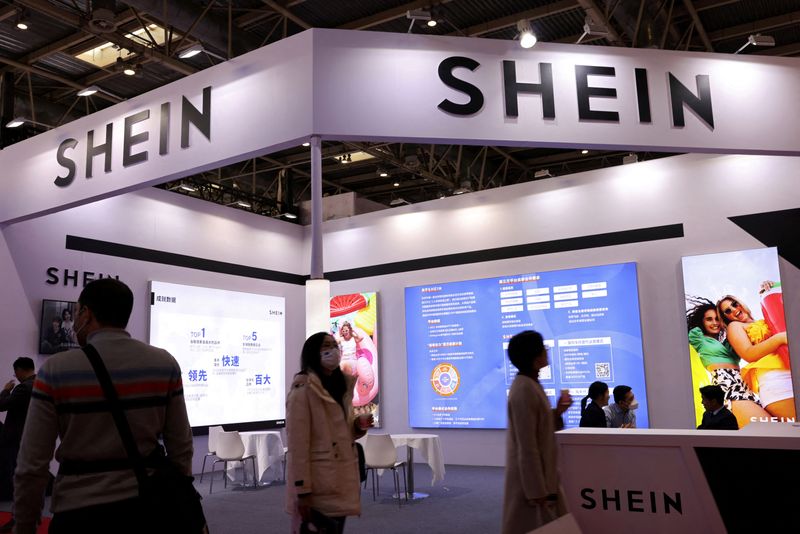How Shein outgrew Zara and H&M and pioneered fast-fashion 2.0
2023.12.13 00:27

© Reuters. FILE PHOTO: People walk past the booth of fashion retailer Shein during the first China International Supply Chain Expo (CISCE) in Beijing, China November 28, 2023. REUTERS/Florence Lo/File Photo
By Katherine Masters
NEW YORK (Reuters) – With Zara-owner Inditex (BME:) and H&M (ST:) set to disclose their most recent sales results, investors will be focused on one major question: how are the two fast-fashion pioneers responding to the current market leader, Shein?
Shein has a huge valuation and is primed for an IPO. With sales almost entirely online, the retailer generated about $23 billion in global revenue in 2022, according to research firm Coresight.
Shein accounted for nearly one-fifth of the global fast-fashion market in 2022, outpacing Zara and H&M. Shein’s low prices – $5 t-shirts and $10 sweaters – also draw shoppers who might have otherwise shopped at clothing discount stores.
“Shein’s actual strength is acknowledging that they have no idea what you want to wear,” said Rui Ma, an analyst and founder of the newsletter Tech Buzz China. “What they have confidence in is their ability to ramp up production very quickly.”
For Inditex, which reports results on Wednesday, and H&M, which reports quarterly sales on Friday, the China-founded e-tailer has emerged as a major threat in the market for cheap clothing and accessories.
On Dec. 6, Deutsche Bank analyst Adam Cochrane downgraded Inditex and H&M to a “sell” rating, citing challenges including price deflation within clothing, and pressure from Shein and its fast-growing competitor, PDD-owned Temu.
H&M declined to comment on Shein’s market share. Zara did not immediately respond to a request for comment.
To be sure, Shein has some features in common with Zara and H&M, which are often credited with spearheading the concept of replicating runway looks and bringing them to shoppers for less, also known as “fast-fashion.”
All three retailers have faced criticism for allegedly stealing designs from other brands, but some critics say that Shein’s super-fast production cycle makes it an especially egregious offender.
A lawsuit in July for intellectual property infringement alleged Shein uses artificial intelligence and a proprietary algorithm to scrape the internet for design ideas, sometimes resulting in direct plagiarism.
But Shein’s key strategy, according to analysts and investors, is to tap a network of largely China-based suppliers, which buck traditional manufacturing trends by accepting small initial orders and scale up based on demand.
That ultra-flexible supply chain allowed Shein to create a fundamentally different business model than established fast-fashion players like Zara and H&M, which pioneered shorter production timelines but still largely rely on predicting what styles shoppers will buy.
“For the most part, a Zara or an H&M is still anticipating fashion trends, pre-ordering that product between three to 12 months ahead of sale, and committing to fairly large order volumes,” said Simon Irwin, a former Credit Suisse analyst who has researched Shein’s pricing strategies.
One 2022 study found Shein typically receives orders within five to seven days and can then send the products directly to consumers via air freight.
Shipping can still take up to two weeks, depending on the product and a shopper’s location. However, the direct-to-consumer model gives Shein an advantage over brick-and-mortar retailers, which must distribute apparel across a global network of stores and keep those locations stocked, according to Sheng Lu, a professor of fashion and apparel studies at the University of Delaware.
Patricia Cifuentes, senior analyst at Bestinver’s securities division, which holds Inditex shares, said delivery speed is a fundamental advantage for Zara compared to H&M and even Shein.
“The sooner a customer receives the garment, the less likely they are to return it. So Inditex wants to be the fastest in sending you the product, but also if you do not like it, they want to put it back into the system as quickly as possible to maximise the chances it will sell at full price.”
From November 2022 to November 2023, Zara and H&M respectively brought 40,000 and 23,000 new items to the U.S. market, according to data from Lu. The data analyzes each retailer’s “stock keeping units,” or SKUs, used to identify individual products, including different sizes of the same garment.
Shein introduced 1.5 million products over the same period – 37 times more than Zara and 65 times more than H&M.
And while both companies still work with suppliers in China, Inditex and H&M have large manufacturing bases in other countries.
In 2022, 98% of Inditex’s production was based in 12 countries, including Portugal, Morocco, Turkey and Spain, where the company is headquartered. H&M counts Bangladesh, along with China, as its largest production market for clothing, a spokesperson said.
Shein declined to comment on its supplier network, but recent import records show virtually all of its products imported in bulk to the U.S. came from China.







